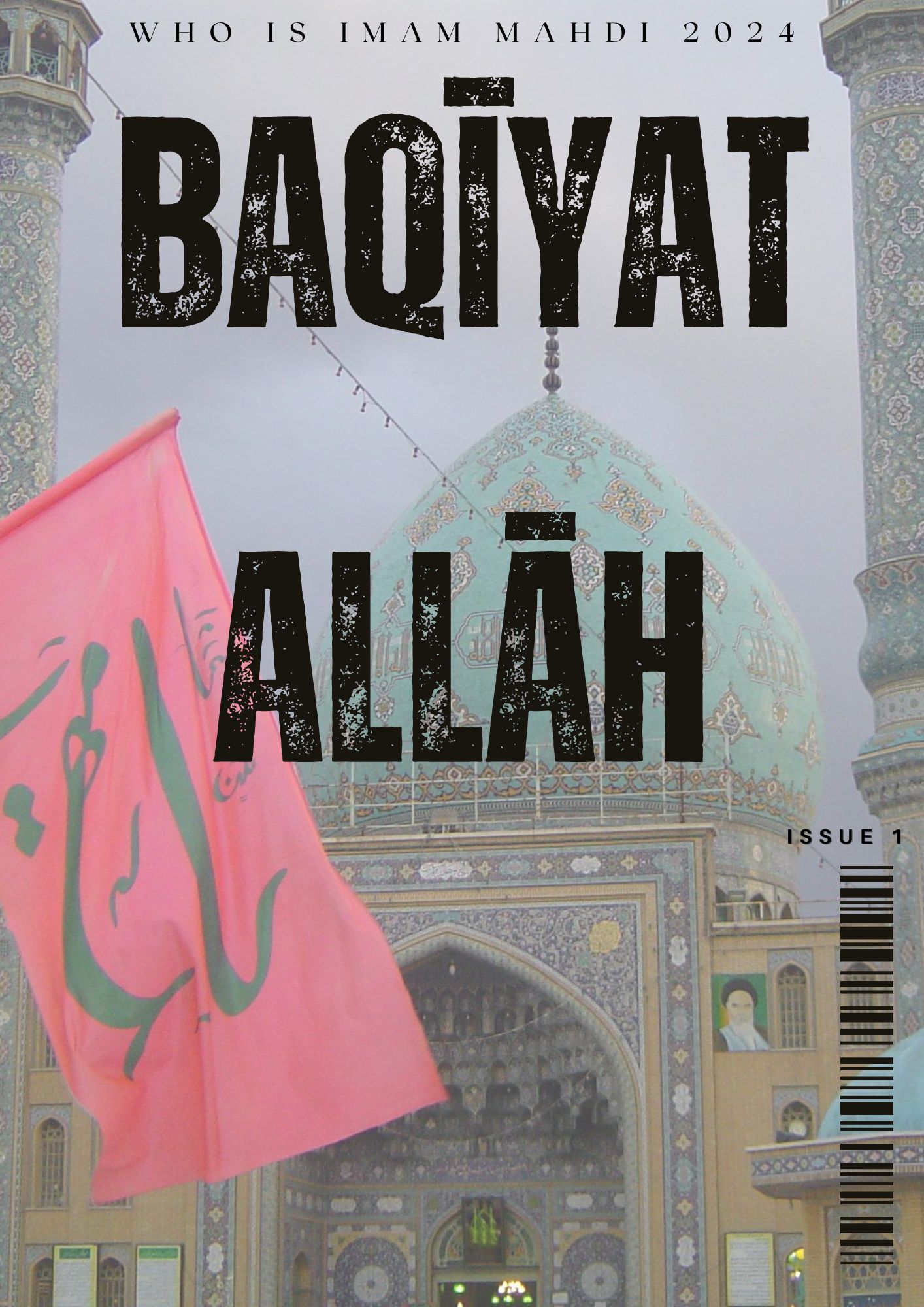
Since the question above is too vague and general and has not specified a certain aspect of Imam Mahdi’s (AJ) life, we have decided to take a brief glimpse at the life of the twelfth Imam, mention a few prophecies of the Quran and traditions regarding Imam Mahdi and finally conclude with listing a number of signs of his reappearance.
The twelfth Imam is named the same as the Prophet (S.A.); meaning “Muhammad” (I’lam al-Wara, pg. 417.), but according to the traditions from the Imams (A.S.) it has been made forbidden to say his name. He has many titles some of which are Mahdi, Muntadhar, (Imam Mahdi az Veladat ta Zuhur, pg. 58.) Sahib al-Asr, etc. Imam Zaman was born in 255 A.H. (Rowdhah al-Wa’idhin, pg. 292.), in the city of Samarra. His great father was the eleventh Imam, Hassan Al-Askari (A.S.) and his respectable mother was Narjis (Ibid, pg. 283.).
The story of the birth of Baqiyyatullah al-A’dham isn’t confined to the books and resources of the Shiite denomination. It is written in authentic Sunni resources (al-Sawa’iq al-Muhriqah, pg. 208.) as well and even non-Muslim denominations and sects conceive it as an undoubted event, although due to certain biases, there are debates and arguments between denominations and sects of non-Muslim religions regarding who the savior of the akhar al-zaman (end of the world) identifies with.
Now, to start with the first section of this article we must say that the twelfth Imam’s life has had four periods:
1. Before the minor occultation
2. The minor occultation
3. The major occultation
4. The reappearance of the Imam
The first period started with his birth in 255 A.H. until 260 A.H., the date of the martyrdom of his great father, making this period a little more than five years in length.
In this period which was the period of growth under his the supervision of the eleventh Imam (A.S.), the Shiites were to learn and recognize who the next Imam whom they were anticipating to be the last Imam and savior of mankind was and for the twelfth Imam to be introduced to his followers so that the martyrdom of the eleventh Imam would not be followed by friction and division.
Therefore, we can conclude the most important event of this period to be the introduction of the twelfth Imam to the Shiite scholars and close ones and secondly explaining occultation and its philosophies amongst the Muslims.
The second period started in 260 A.H., after the martyrdom of the eleventh Imam and the Imamah of the twelfth Imam and lasted up to 329 A.H. This period was the period of training and preparing the Shiites for the major occultation. Therefore, the Imam (AJ) would communicate through four deputies; four of the most pious Shiites. Practically, they were the connection between the Imam and the Muslims and were recognized as the special representatives of the Imam. Their names were:
1. Abu Amr Uthman bin Sa’eed al-Amri
2. Abu Ja’afar Muhammad ibn Uthman ibn Sa’eed Amri
3. Abul-Qasem Hussein ibn Ruh Nowbakhti
4. Abul-Hassan Ali bin Muhammad Samari (Saymari)
The time had come for the Muslims to follow their Imam (A.S.) without visual appearance and direct relations and the Muslims had been prepared by the eleventh and twelfth Imam in the first and second period to accept the major occultation. Thus, the Imam wrote a letter (Majlisi, Bihar al-Anwar, vol. 51, pg. 361.) to Ali ibn Muhammad, his last deputy, foretelling his death, clarifying that there will be no other special representative of the Imam after him and in reality announcing the commencement of the major occultation and conclusion of the second period.
The third period which we are currently in, began in 329 A.H., after Ali ibn Muhammad passed away and will continue till the reappearance of his holiness. This period was the period of struggle and endeavor for Shiite scholars and spiritual connection of Muslims with the Imam. In this stage the difficulties of people is resolved by his hands, and he is the one who assists the Muslims in decisive moments of hardship. There are very little people who have not personally experienced his blessing in their life.
Due to deprivation of visual contact and direct relation, the Imam has assigned general deputies (Hurr Amili, Wasa’il al-Shia, vol. 18, pg. 101.), meaning the Shiite scholars and faqihs, and ordered his followers to follow them in the face of contemporary issues and events, and to resolve their bewilderment by asking them for rulings and their specific duties.
The fourth period of Imam Al-Asr’s life is after the third period and starts with his reappearance, the date of which no man bears the knowledge of. The traditions assert that his reappearance will be at a time where corruption and destruction will be at its highest all over world to the extent where the only path to salvation would be a global revolution and the oppressed people would be waiting and anticipating the reappearance of his greatness.
It is at that time that, according to God Almighty, ease will spread after hardship and the reemergence of Imam Al-Asr (AJ) will occur. He will come and free the world from aggression and oppression and implement the true religion of Islam, making the world a true utopia. At that time the oppressed will take an easy breath and the social classes will be eliminated and the superiority of human beings will be classified not by their color, ancestors and social classes but merely by their taqwa.
It has been said that his holiness will be martyred just like his ancestors after twenty years of divine rule (Imam Mahdi az Veladat ta Zuhur, pg. 779.) and that his martyrdom will be the start of the resurrection (raja’h) of previous Imams. This is the divine day of return to the righteousness.
After mentioning the four periods of his life we will now elaborate on the second section, the prophecies of the twelfth Imam (A.S.) and his government seen within the Quran and ahadith.
We must note that when the Quran foretells future events it refrains from mentioning the exact name of the individual, event or location and instead simply refers to the details and qualities and therefore, only referred to the qualities and details which can’t identify with any character but the twelfth Imam (A.S.). An example of these verses can be verse 5 and 6 from Surah Qasas, where He says: “And We desired to bestow a great favor upon those who were deemed weak in the land, and to make them the leaders and heirs”.
In another verse He says: “He is Who sent His Messenger with guidance and the religion of truth, that He might cause it to prevail over all religions.”
Other verses such as verse 55 of Surah Al-Nur and verse 105 of Surah Anbiya’ have been revealed about the twelfth Imam (AJ) and it is evident that if we do not see the one being referred to in them to be Imam Mahdi, these verses will basically be impractical and dreamlike words that don’t fit with the truth and miraculousness of the Quran. For the interpretation and ta’wil of the said ayahs, you can refer to more detailed resources.
There are many traditions from the Prophet about the reappearance of the promised Mahdi (A.S.). According to Shahid Sadr (R.A.) if we count the total of traditions within the Sunni and Shiite resources they will surpass 6000 hadith. (Fara’id al-Samtayn, vol. 2, pg. 335. Quoted from Imam Mahdi az Veladat ta Zuhur, pg. 102.) Here, we will simply mention one of these ahadith for consecration. In a hadith narrated from the Prophet (S.A.), he states: “The Mahdi is one of my children. He will be in occultation…and after that he will return and fill the world with justice and equity, the same way it was full of oppression and tyranny.” (Pishva’i, Mahdi, Sireye Pishvayan, pg. 697.)
Sunni sources contain numerous mutawatir hadiths which leave no doubt about the existence of Imam Mahdi (AJ). Some of these sources have been written before the birth of Imam Mahdi by Muslim scholars. (See: Imam Mahdi az Veladat ta Zuhur, pp. 464-561.)
Finally, in the last section of this article we will discuss the signs of his reappearance. (Sadr, Muhammad Baqir, Imam Mahdi Hemase’i az Nur, trans., The Grand Islamic Library, pp. 66.) They are divided into two groups, the definite and indefinite signs.
The indefinite signs are signs which show that the event is near. The number of these signs is fairly high, some of which are as follows:
1. The rise of a man from the family of the Prophet
2. The rising of black flags in Khurasan
3. Eclipse
4. A long period of rain
5. A world war
Definite signs are signs that will definitely take place by God’s will:
1. The progressive movement of the people of Yemen
2. The devolutionary movement of the Sufyani
3. The heartwarming calling from the sky
4. The sinking of land in earthquakes
5. The murder of the Nafs Zakiyyah (The Pure Soul)
In the end we must add that the aforementioned are the consensus of Muslims scholars regardless of being Sunni or Shiite.
Resources for further study:
1. Tabarsi, Fadhl ibn Hassan, I’lam al-Wara’ bi-A’lam al-Huda.
2. Ibn Hajar, al-Sawa’iq al-Muhriqah.
3. Sadr, Seyyed Sadruddin, al-Mahdi.
4. Qazwini, Seyyed Muhammad Kadhim, Imam Mahdi az Veladat ta Zuhur, translated by: Ali Karami and Muhammad Husseini.
5. Imam Mahdi, Hemase’i az Nur, Shahid Muhammad Baqir Sadr.
6. Bihar Al-Anwar, Muhammad Baqir Majlisi
7. Rouwdhat ul-Wai’dheen, Muhammad Ibn Fattal Neishabouri.
8. Sireye Pishvayan, Mahdi Pishva’i.
9. Muntakhab al-Athar fi al-Imam al-Thani Ashar, Lutfullah Safi.
10. Wasai’l Al-Shi’a, Sheikh Hurr Amili. (Islamquest)

